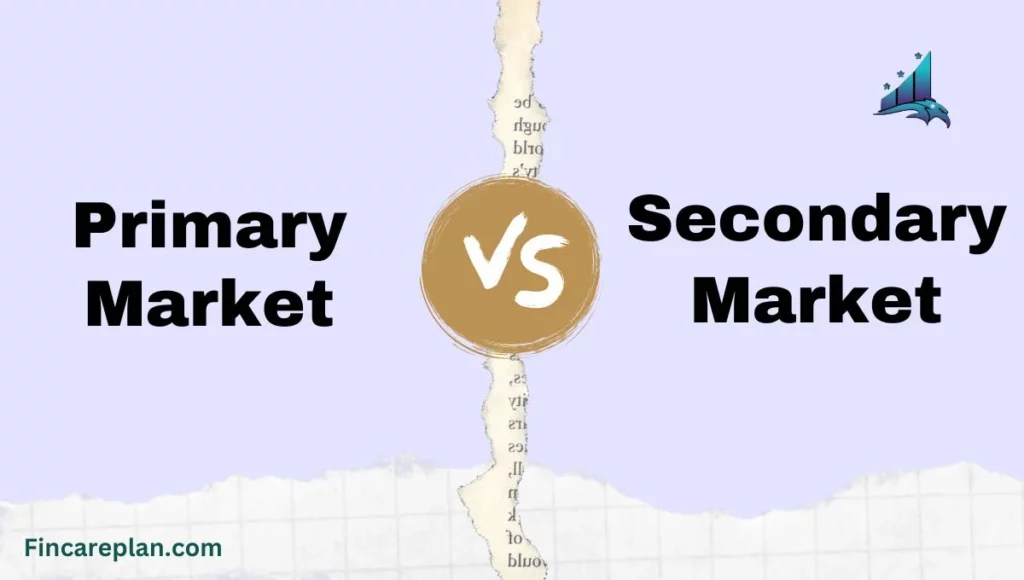Table of Contents
ToggleA financial market that includes all institutions, organizations, and instruments providing medium and long-term funds that bring buyers and sellers together to trade stocks, bonds, currencies, and other financial assets is known as a Capital Market. Mutual funds, public deposits, bonds, shares, etc., are common instruments in a capital market.
A capital market does not provide funds for a short term, i.e., up to one year. There are two types of capital markets: Primary Market and Secondary Market.
Before trying it in capital markets, you must know these two distinct terms: primary and secondary markets. They act as a key to navigating and gaining profits in trading. The primary market refers to the market where securities are issued, created, and sold to investors, while in the secondary market, these securities are traded among investors.
In this blog, we will briefly analyze the primary and secondary markets to see how they can help you stabilize your position in the capital market.
Difference Between Primary Market and Secondary Market
| Feature | Primary Market | Secondary Market |
|---|---|---|
| Nature of the Market | Typically, lower trading volume due to the limited availability of newly issued securities. | Previously issued or second-hand securities are bought and sold among investors. |
| Issuer’s Involvement | There is no direct trading connection to the issuer; securities are traded between interested investors. | The securities exchange happens between the issuer (company or government) and investors. |
| Capital Generation | Direct contribution to the capital of a company; investors purchase newly issued securities. | Transactions don’t produce capital directly for the issuer; investors buy and sell existing securities. |
| Price Determination | Enables companies or governments to raise funds for activities/projects through the issuance of securities. | Price is fixed by the issuer using techniques like fixed pricing or book-building procedures. |
| Regulation | Subject to regulatory requirements and scrutiny to protect investors’ interests. | Regulated but typically have less stringent requirements compared to the primary market. |
| Volume | Provides liquidity to investors, enabling the exchange of securities and entry/exit points for investments. | Higher trading volume as investors can freely buy and sell existing securities multiple times. |
| Purpose | Enables companies or governments to raise funds for activities/projects by issuing securities. | Enables companies or governments to raise funds for activities/projects by issuing securities. |
| Intermediaries | Investment Bankers | Brokers |
| Examples | IPOs, Bond offerings | Stock exchanges, OTC markets |
| Validity | Securities can be traded only one time | Securities can be traded for infinite times. |
What is the Primary Market?
A primary Market is an instrument where securities like equity shares, bonds, and debentures are issued to the public for the first time. It is also known as a New Issue Market.
In the Primary Market, securities are sold for the first time, i.e., fresh securities are issued from the company under this market. Here, the securities are created to contribute to a company’s capital formation directly. The company directly deals with the investors and uses the finance for investment in machines, land, buildings, equipment, etc.
The buyers may be institutional or retail investors. An initial public offering (IPO) is an example of a primary market. The primary market notices the release of new securities through IPOs or FPOs. Thus, the primary market is like a shop where governments or companies sell brand-new shares or bonds to raise funds.
What is the Secondary Market?
In a Secondary market, investors sell and purchase newly issued securities such as shares or bonds, and second-hand securities are made. A company that originally issued the securities is not directly involved in this market. Instead, the company’s investors sell the securities to other investors.
Here, in the secondary market, the investor who wishes to sell the securities and the one who wants to purchase the securities meet each other and exchange the securities for funds with the help of an intermediary, maybe a broker, without the issuing companies’ involvement. It is also called ‘Issue market’.
It helps companies fulfill short-term liquidity requirements and facilitates the marketability of existing securities. The value of these securities differs based on supply and demand. These markets include stock exchanges like the Bombay Stock Exchange (BSE) and the National Stock Exchange (NSE).
The best example of a Secondary Market is Amazon (AMZN), where Amazon is not directly involved but instead through some investor who owns a share in Amazon.
Conclusion
Thus, the two financial markets, primary and secondary, play a major role in mobilizing money and aid in the development of the country’s economy. The basic difference between them is based on the type of companies and investors.
In the primary market, companies initially trade with the public, whereas in the secondary market, they trade between investors. With this helpful information, you can easily meet your needs according to your stability.
FAQs
-
Can an investor sell their shares directly to the company in the secondary market?
You can sell your shares back to the company only through an intermediary, maybe a broker.
-
Why is the secondary market important for the success of the primary market?
Secondary markets create additional economic value by allowing more beneficial transactions and increasing an asset’s fair value. They also provide liquidity to the economy, as sellers can sell quickly and easily due to the large number of buyers in the market.
-
Are there any securities that are traded exclusively in the primary market or the secondary market?
The primary market includes common and preferred stock, corporate bonds, and government bonds, whereas the secondary market includes fixed-income, variable-income, and hybrid instruments.
